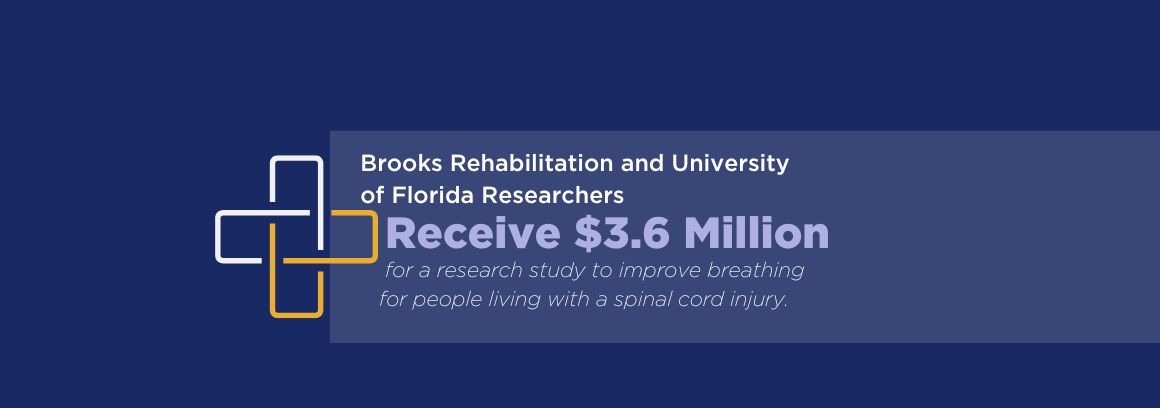Brooks Rehabilitation and University of Florida Receive $3.6 Million Grant to Accelerate Research to Improve Breathing in Chronic Spinal Cord Injury

Back to physical health resource hub
A new treatment known as therapeutic acute intermittent hypoxia (AIH) has shown promise for improving breathing ability in people living with chronic spinal cord injury. However, research shows that 40% of individuals show minimal response to the benefits of AIH treatment. With the support of a four-year, $3.6 million grant from the Department of Defense, Brooks Rehabilitation and University of Florida College of Public Health and Health Professions (UF PHHP) researchers will investigate ways to make the treatment more effective and use genetic biomarkers to identify which individuals will benefit most from AIH. This collaboration with the UF Breathing Research and Therapeutics (BREATHE) Center will be conducted at the Brooks Clinical Research Center in Jacksonville.
Breathing impairment is the leading cause of infection, re-hospitalizations and death in those living with spinal cord injury. The injury can disrupt neural pathways from the brain to respiratory motor neurons in the spinal cord, decreasing breathing ability and airway defense. Although the level of respiratory dysfunction varies widely in individuals, even moderate breathing impairment greatly increases the chance of life-threatening lung infections and the need for life-long ventilator support.
In therapeutic acute intermittent hypoxia, participants are given repetitive, brief periods of low oxygen. Typically, just 15, one-minute episodes are used, and most participants can’t tell the difference between the low-oxygen treatment and breathing in room air. To date, no adverse events have been reported, consistent with a growing body of evidence that suggests “low-dose” AIH protocols are simple, safe and effective. The intervention is expected to improve breathing ability by promoting spinal neuroplasticity as well as the ability to strengthen pathways and neural connections that were spared from injury.
Previous studies showed profound effects of AIH on both breathing and non-breathing neurons, while establishing that AIH effects are increased when hypoxia is combined with low levels of carbon dioxide. It is still unclear if this combined treatment causes greater recovery in individuals with spinal cord injury. This four-year study seeks to answer that question.

The study will be led by principal investigator, Emily Fox, P.T., Ph.D., director of the Brooks/UF PHHP Research Collaboration and associate professor of physical therapy at the UF College of Public Health and Health Professions. She is also director of neuromuscular research at Brooks Rehabilitation.
For this new study, Fox and co-principal investigator Gordon Mitchell, Ph.D., UF preeminent professor of physical therapy, director of the BREATHE Center, and deputy director of the McKnight Brain Institute, will test whether combining therapeutic AIH with a slight increase in carbon dioxide will enhance outcomes for patients with spinal cord injury versus AIH alone. Their initial outcomes in uninjured individuals indicate neuroplasticity and diaphragm (the primary breathing muscle) activation are increased when this gas mixture is used. The study team also seeks to identify genetic biomarkers in order to predict which individuals benefit most, or least, from the intervention.
“This study is a critical step in our research programs (at UF and Brooks) to develop therapeutic approaches that amplify the effects of rehabilitation and advance recovery for people with spinal cord injury and other neurologic conditions. Therapeutic AIH holds great promise because of its beneficial effects on functional recovery as well as its safety profile and ease of application in rehabilitation. This study will not only advance the understanding and use of this approach, but help ensure future trials and clinical use target those most likely to benefit,” said Dr. Fox.
The study will enroll 62 individuals with chronic spinal cord injury to participate. The first participant enrolled in January of this year.
“This is a remarkable example of true translation in biomedical research, where ideas inspired by fundamental, preclinical studies in rodent models are followed by validation in human subjects, leading to this clinical trial. We have an exceptional partnership between biomedical and clinical investigators that truly listens, learns and translates in ongoing efforts to develop new therapies for people living with chronic spinal cord injury. Dr. Fox and her Brooks team epitomize that preclinical to clinical partnership as we work to create real solutions to benefit patients,” said Dr. Mitchell.
Photo caption:
Researchers Dr. Gordon Mitchell (back left) and Dr. Emily Fox (back right) work with study team at Brooks Rehabilitation to test breathing intervention on individual with spinal cord injury.


